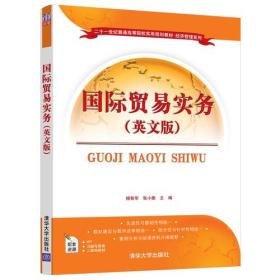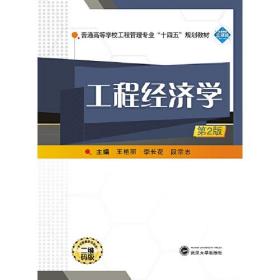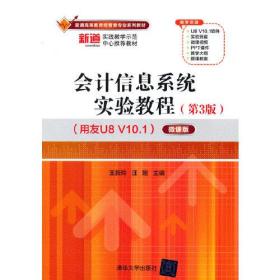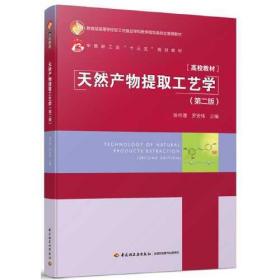
国际贸易实务(英文版)
正版85品 有笔记发圆通
¥ 4.85 1.0折 ¥ 49.8 八五品
库存33件
浙江金华
认证卖家担保交易快速发货售后保障
作者杨智华;张小衡
出版社清华大学出版社
出版时间2018-09
版次1
装帧平装
货号9787302509448
上书时间2024-08-20
- 在售商品 暂无
- 平均发货时间 10小时
- 好评率 暂无
- 最新上架
商品详情
- 品相描述:八五品
图书标准信息
- 作者 杨智华;张小衡
- 出版社 清华大学出版社
- 出版时间 2018-09
- 版次 1
- ISBN 9787302509448
- 定价 49.80元
- 装帧 平装
- 开本 16开
- 页数 302页
- 字数 99999千字
- 【内容简介】
-
《国际贸易实务》(英文版) 结合我国的进出口贸易实践,秉承培养进出口经理人的目标以货物进出口贸易中的习惯做法、贸易惯例和法律为依据,详细介绍了国际货物买卖合同的订立、合同中的主要交易条款和条件、货物的交付、货运保险、货款结算、以及合同履行过程中的制单和争议的解决问题。
为尽可能地贴近进出口贸易的实际并适应现实的需求,本书采用全英文编写,引导读者从总体上把握进出口业务流程、相关的法律法规和惯例,针对重点和难点内容设计、选用了相关问题和案例,并配有在线课程学习资源方便读者学习使用。 - 【目录】
-
chapter 1 introduction 1
1.1 lead-in 1
1.2 features of international transactions 3
1.2.1 transaction risks 3
1.2.2 institutional and political risks 4
1.3 organizations and legal environment of international trade 5
1.3.1 international trade organizations 5
1.3.2 legal system of international trade 6
1.4 three-step trade process 7
1.4.1 preparation for contract 8
1.4.2 negotiation of contract 8
1.4.3 performance of contract 9
1.5 general procedure of export and import 10
1.5.1 for export on cif term with payment by l/c 10
1.5.2 for import on fob term with payment by l/c 11
1.6 scope of this book 12
exercise 13
part ⅰ formation of contracts
chapter 2 business negotiation 18
2.1 lead-in 18
2.2 inquiry 19
2.3 offer 20
2.3.1 what is an offer? 20
2.3.2 effectiveness of an offer 24
2.4 counteroffer 26
2.5 acceptance 26
2.5.1 what is an acceptance? 26
2.5.2 late acceptance 28
2.5.3 withdrawal of an acceptance 29
2.6 contracts in writing 29
2.6.1 countersignature 30
2.6.2 elements of international s/c 31
exercise 33
part ⅱ subject terms
chapter 3 name and quality 36
3.1 lead-in 36
3.2 name of modity 36
3.3 quality of modity 37
3.3.1 sale by sample 37
3.3.2 sale by description 39
exercise 43
chapter 4 quantity 45
4.1 lead-in 45
4.2 systems of units 45
4.2.1 imperial system and
us customary system 45
4.2.2 international system of units 46
4.2.3 to clearly define the adopted system 46
4.3 how to measure weight 47
4.3.1 weight, tare weight and gross weight 47
4.3.2 other weights 48
4.4 quantity tolerance 49
4.4.1 quantity tolerance in s/c 49
4.4.2 quantity tolerance in l/c 50
exercise 50
chapter 5 packaging 52
5.1 lead-in 52
5.2 importance of packaging in import and export 53
5.2.1 to protect the goods during transit 53
5.2.2 to facilitate transportation 53
5.2.3 to promote sales 53
5.3 types of packaging materials 54
5.3.1 individual packaging materials 54
5.3.2 unitized packaging materials 56
5.4 marks on packages 60
5.4.1 marks on individual shipping packages 60
5.4.2 marks on containers 63
exercise 65
part ⅲ price
chapter 6 trade terms 69
6.1 international rules associated with trade terms 69
6.2 main features of incoterms 2010 71
6.3 basic concepts related to trade terms 73
6.3.1 critical points 73
6.3.2 obligations 74
6.3.3 free 74
6.3.4 customs clearance and formalities 75
6.4 fob, cfr and cif of incoterms 2010 75
6.4.1 fob 75
6.4.2 cfr 77
6.4.3 cif 79
6.4.4 parison of fob, cfr and cif 81
6.5 fca, cpt and cip of incoterms 2010 82
6.5.1 fca 82
6.5.2 cpt 83
6.5.3 cip 84
6.5.4 parison of fca, cpt and cip 85
6.6 other trade terms of incoterms 2010 86
6.6.1 exw 86
6.6.2 fas 86
6.6.3 dat 87
6.6.4 dap 87
6.6.5 ddp 87
exercise 88
chapter 7 export pricing and quotation 90
7.1 pricing strategies 90
7.1.1 pricing objectives 90
7.1.2 pricing strategies 91
7.2 price calculation for international sale 92
7.2.1 cost 92
7.2.2 expenses 94
7.2.3 expected profit 97
7.3 foreign exchange risk 98
7.3.1 hazards of foreign exchange risk 98
7.3.2 fx volatility and controls 99
7.3.3 options to manage fx risk 99
exercise 101
part ⅳ delivery
chapter 8 marine cargo transport 104
8.1 lead-in 104
8.2 shipping services 105
8.2.1 liner service 105
8.2.2 charter service 107
8.3 multimodal transport and containerization 110
8.3.1 multimodal transport 110
8.3.2 containerization 112
8.4 marine shipping documents 113
8.4.1 bill of la (b/l) 113
8.4.2 sea waybill 124
exercise 125
chapter 9 other modes of cargo transport 127
9.1 lead-in 127
9.2 rail transport 127
9.3 road transport 129
9.4 air transport 130
9.5 other modes of transport 132
exercise 134
chapter 10 shipping terms 136
10.1 lead-in 136
10.2 time of shipment 136
10.3 port of shipment and port of destination 137
10.4 partial shipment 140
10.5 transshipment 142
10.6 advice of shipment 143
exercise 143
part ⅴ insurance
chapter 11 marine cargo insurance 146
11.1 lead-in 146
11.2 concepts and principles of insurance 146
11.2.1 concepts in insurance
business 146
11.2.2 principles of insurance 147
11.3 risks, losses and expenses in marine transport 150
11.3.1 risks in marine transport 150
11.3.2 losses in marine transport 151
11.3.3 expenses in marine transport 154
11.4 ocean marine cargo clauses 155
11.4.1 basic coverage 156
11.4.2 additional risks 161
11.5 cargo insurance for land and air transport and parcel t 163
11.5.1 overland transportation cargo insurance clauses(train, truck) 163
11.5.2 air transportation cargo insurance clauses 164
11.5.3 parcel t insurance clauses 165
11.6 institute cargo clauses 166
11.6.1 icc (a) 166
11.6.2 icc (b) 167
11.6.3 icc (c) 168
11.6.4 summary of the institute cargo clauses 169
exercise 170
chapter 12 cargo insurance practice 172
12.1 arranging cargo insurance 172
12.1.1 who should arrange insurance? 172
12.1.2 choice of insurance coverage 173
12.2 insured amount and insurance premium 174
12.2.1 insured amount 174
12.2.2 insurance premium 174
12.3 insurance documents 175
12.3.1 types of insurance documents 175
12.3.2 contents of the insurance policy 177
12.4 insurance claim 178
exercise 180
part ⅵ payment
chapter 13 negotiable instruments 184
13.1 lead-in 184
13.2 bill of exchange 184
13.2.1 requisite form 185
13.2.2 types of bills 187
13.2.3 use of bills 188
13.3 promissory note 189
13.3.1 requisite form 189
13.3.2 types of promissory notes 190
13.4 check 191
13.4.1 what is check? 191
13.4.2 types of check 192
exercise 193
chapter 14 remittance and collection 195
14.1 lead-in 195
14.2 remittance 195
14.2.1 what is remittance? 195
14.2.2 types of remittance 195
14.3 collection 198
14.3.1 what is collection? 198
14.3.2 types of collection 198
14.3.3 finance in payment by collection 201
14.3.4 risk parison of different types of collection 202
exercise 203
chapter 15 documentary credit 205
15.1 lead-in 205
15.2 what is letter of credit? 206
15.2.1 definition 206
15.2.2 parties involved 206
15.2.3 features 207
15.2.4 contents 208
15.3 types of credits 210
15.3.1 irrevocable credit and revocable credit 210
15.3.2 negotiable credit 210
15.3.3 sight credit and time credit 211
15.3.4 confirmed credit 211
15.3.5 transferable credit 212
15.3.6 back-to-back credits 212
15.3.7 reciprocal credits 213
15.4 payment by letter of credit 213
15.4.1 payment by non-negotiable credit 213
15.4.2 payment by negotiable credit 214
15.5 expedition of l/c establishment 216
15.6 amendment of l/c 217
15.6.1 how to proofread l/cs 217
15.6.2 how to ask for amendment 222
15.7 terms in sales contracts 223
15.7.1 l/c as the only payment mode 223
15.7.2 l/c with other payment mode 223
exercise 225
chapter 16 documentation 229
16.1 process of contract implementation 229
16.1.1 goods preparation 229
16.1.2 inspection process 230
16.1.3 shipping, insurance and customs clearance 231
16.1.4 plying presentation under letter of credit 232
16.2 export documents required by the credit 234
16.2.1 draft 234
16.2.2 invoice 235
16.2.3 packing list 238
16.2.4 bill of la 239
16.2.5 insurance documents 240
16.2.6 inspection certificates 241
16.2.7 certificates of origin 245
16.2.8 other documents related to
export 250
exercise 253
part ⅶ dispute
chapter 17 inspection, claim and force majeure 256
17.1 lead-in 256
17.2 modity inspection 256
17.2.1 what is modity inspection 256
17.2.2 time and ces of modity inspection 257
17.2.3 modity inspection bodies 258
17.2.4 china inspection and quarantine (ciq) 260
17.2.5 inspection certificates 261
17.2.6 inspection clauses in sales
contract 263
17.3 claim 263
17.3.1 breach of contract 263
17.3.2 discrepancy and claim clause 265
17.3.3 penalty clause 266
17.4 force majeure 267
17.4.1 what is force majeure 267
17.4.2 force majeure clause in sales contract 268
exercise 269
chapter 18 arbitration 271
18.1 dispute resolution processes 271
18.2 arbitration agreement 273
18.2.1 what is arbitration agreement 273
18.2.2 contents in arbitration agreement 273
18.3 arbitral award 276
exercise 280
glossary 283
referenceskdy 300
点击展开
点击收起
相关推荐
— 没有更多了 —






















以下为对购买帮助不大的评价